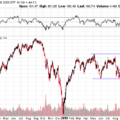In a Nutshell: Commodities started the year off strong as the rising inflation narrative builds. Stocks pulled back to start the year, while interest rates stayed steady.
Domestic Equity: Slow Start to 2021
Many stocks had such an incredible run to close out 2020, it seemed like a cool off was inevitable. Right on cue, the SP500 ended January down 1.1%. Our monthly SP500 range bands have now gone an impressive five for five since 2017 in indicating when stocks will cool off. Most of these signals lead to multi-month pull backs, so this bears monitoring.
January returns have an uncanny ability to indicate the returns on the year. According to the Stock Trader’s Almanac, since 1950, 86% of the time, as January goes, so goes the year for the SP500. Last year was an exception — like it was in so many other ways — to this historical trend.
The Federal Reserve met in January and reiterated their desire to keep interest rates at zero and implored Congress to work toward fiscal support for the economy. Additionally, they restated their comfort level with rising inflation over the next few years.
Global Equity: Getting Too Hot?
Emerging markets (EM) continue to run hotter and stronger than U.S. stocks, but have they gone too far, too fast? Using bands representing two standard deviations from the overall trend, we can see that EMs have breached the upper band for the third time in just over three years.
This doesn’t have to lead to large pull backs, but the last two occurrences in the first quarter of both 2018 and 2020 have been large. With the U.S. dollar finding recent support and creating a headwind, this is a situation we’ll be watching closely.
Real Estate: Starting the Year Out Strong
Real Estate had a rare month of out performance against stocks to start the year. Albeit slowly, the price action of real estate continues to take small strides in the right direction. There are still a lot of unknowns in this investment space. Congress has indicated that forbearance for renters will likely be extended until the back half of 2021 with little detail on how the landlords will be made whole. Our economy will need to reopen at a rapid pace to support this sector. Being underweight in real estate until then seems wise.
Commodities: Breaking a 13 Year Downtrend, Silver Madness
If there was one sector to avoid in the 2010s, it was commodities. The index for the sector lost nearly 80% from its peak in 2008 to the trough in 2020. This downtrend appears to have broken as the broader sector is now trading on the good side of the long term down trendline. We mentioned previously that getting and staying above $20 was important for the index. With $20 in the rearview mirror, $23 looks to be a very important level for the year. Above it and there is lots of room to run for the sector. The short-term trends of increased inflation expectations, weaker dollar, and anticipated deglobalization will need to continue to push this sector higher.
With all of the noise about silver this past week, we’d be remiss in not addressing it. Price is the ultimate signal when noise picks up and price looks constructive despite the uptick in volatility. On a long term outlook, silver is at a key level. Zooming in shows what appears to be another consolidation/breakout pattern not that dissimilar from what we saw in the spring of last year. A new 52-week high for silver likely pushes this metal much higher.
Fixed Income: Are Bonds Sniffing Out Inflation?
Inflation expectations are now at an eight-year high as the bond market continues to anticipate increasing inflation. You can see the trend highlighted below by the relationship of inflation protected bonds against traditional bonds of the same tenor. After breaking a multi-year down trend, the inflation adjusted bonds are riding a solid uptrend.
Long dated bonds are most heavily influenced by inflation and future growth prospects. The expectation of inflation is pressing the 30-year bond rate up to a major trendline years in the making. If long rates pop through this level, rates, and likely inflation, will increase. This increase in rates would put a lot of downward pressure on traditional buy and hold portfolios highly allocated to bonds.
All Terrain Portfolio Update
The All Terrain Portfolio has reduced a small amount of risk while continuing to hold risk assets small in size and narrow in focus. We continue to scale into our positions methodically over time in order to better absorb the current highly volatile investment environment. We will continue to follow our methodology and indicators to find buying opportunities and manage risk.
Past performance is not indicative of future results. Other asset classes or investment vehicles may be used in client portfolios and client portfolios may not hold all positions of the model at the same time as the model. This chart and its representations are only for use in correlation to the proprietary timing model by Arkenstone Financial, Registered Investment Advisor. Actual client and All Terrain Portfolio(TM) positions may differ from this representation.
- U.S. Stocks Make New Highs - December 6, 2024
- Rising Rates Create Headwinds - November 8, 2024
- The Fed Finally Cuts Rates - October 10, 2024



Leave a Reply